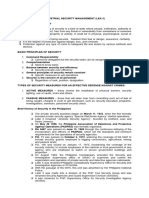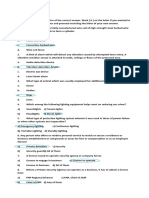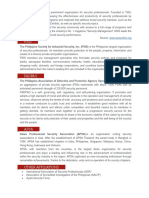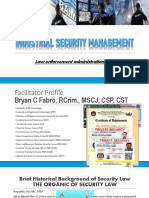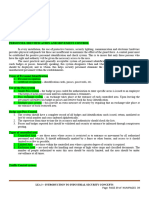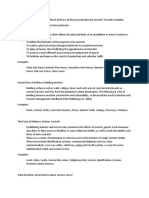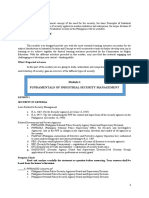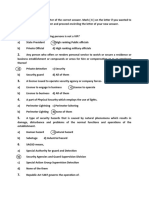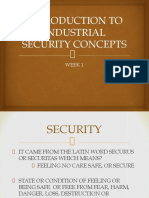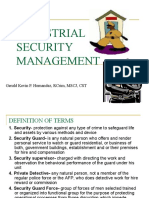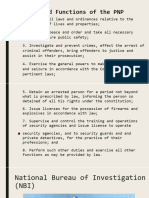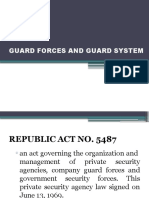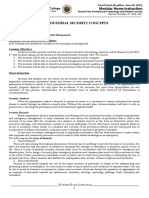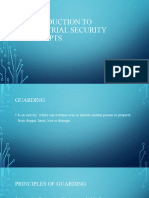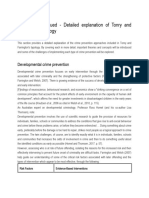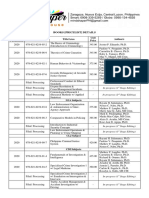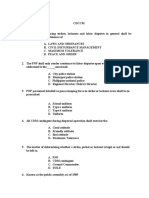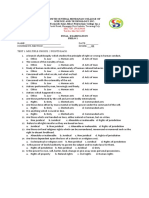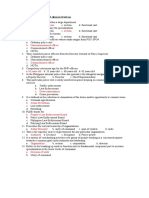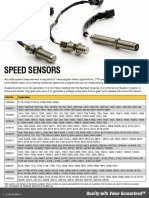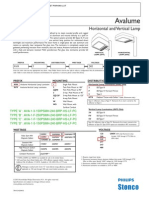FUNDAMENTALS OF INDUSTRIAL SECURITY A.Y.
2022-2023
PHYSICAL SECURITY
What is Physical Security?
Physical security measures are being used to define, protect, and monitor property
rights and assets. These measures consist of barriers and devices that would detect,
impede, and prevent unauthorized access to equipment, facilities, material and document
and to safeguard them against espionage, sabotage, damage and theft.
It may be also defined as the safeguarding by physical means, such as guard, fire
protection measures, of plans, policies, programs, personnel, property, utilities, information,
facilities and installation against compromise, trespass, sabotage, pilferage, embezzlement,
fraud, or other dishonest criminal act.
Principles of Physical Security
1. The type of access necessary will depend upon a number of variable factors and
therefore may be achieved in a number of ways.
2. There is no impenetrable barrier.
3. Defense-in depth is barriers after barriers.
4. Delay is provided against surreptitious and non-surreptitious entry.
5. Each installation is different.
Three Line of Physical Defense
1. First line of Defense – perimeter fences/ barriers.
2. Second line of defense – doors, floors, windows, walls, roofs and grills and other entries
to the buildings.
3. Third line of defense – storage system like steel cabinets, safes, vaults and interior files.
What is Barrier?
A barrier can be defined as any structure or physical device capable of restricting,
deterring, delaying, illegal access to an installation.
Generally, a barrier is use for the following purposes:
Page 1 of 14
� FUNDAMENTALS OF INDUSTRIAL SECURITY A.Y. 2022-2023
1. Define the physical limits of an area.
2. Create a physical and psychological deterrent to unauthorized entry.
3. Prevent penetration therein or delay intrusion, thus, facilitating apprehension of intruders.
4. Assist in more efficient and economical employment of guards
5. Facilitate and improve the control and vehicular traffic.
Types of Barriers
1. Natural barriers – it includes bodies of waters, mountains, marshes, ravines, deserts or
other terrain that are difficult to traverse.
2. Structural barriers – these are features constructed by man regardless of their original
intent that tends to delay the intruder. Examples are walls, doors, windows, locks, fences,
safe, cabinets or containers etc.
3. Human barriers – persons being used in providing a guarding system or by the nature
of their employment and location, fulfill security functions. Examples are guards, office
personnel, shop workers, etc.
4. Animal barriers – animals are used in partially providing a guarding system. Dogs are
usually trained and utilized to serve as
guard dogs. German shepherds are best suited for security functions. Goose and turkeys
could also be included.
5. Energy barriers – it is the employment of mechanical, electrical, electronic energy
imposes a deterrent to entry by the potential intruder or to provide warning to guard
personnel. These are protective lighting, alarm system and any electronic devices used as
barriers.
What is a Restricted Area?
A restricted area is any area in which personnel or vehicles are controlled for
reasons of security. Restricted area is established to provide security for installation or
facilities and to promote efficiency of security operations and economy in the use of security
personnel.
Types of Restricted Areas
Two types of restricted areas may be established to permit different degrees of
security within the same installation or facility, and to provide efficient bases for the
Page 2 of 14
� FUNDAMENTALS OF INDUSTRIAL SECURITY A.Y. 2022-2023
application of different degrees of access, circulation and protection. These restricted areas
are termed Exclusion areas and Limited areas.
Exclusion Area. An exclusion area is a restricted area which contains a security
interest to TOP SECRET importance, and which requires the highest degree of protection.
Limited Area Control. A limited area is a restricted area in which a lesser degree of
control is required than in an exclusion area but which the security interest would be
compromised by uncontrolled movement.
Limited Area Control includes the following:
a. Interior Area Control. Interior area control is generally affected in two ways. The first
method is the system which is initiated and terminated at the outer limits of the area to
determine the movements of a visitor within the area. A second somewhat less means of
accomplishing the same thing is time travel. This system provides for checking the actual
time used by the visitor against known time requirements for what the visitor is to
accomplish.
b. Visitor Identification and Movements Control. Processing and control of movements
of visitor shall be included in the PASS SYSTEM. The control of movements of visitor will
depend on the installation. A visitor register shall be maintained to include the name of the
visitor, date of visit, purpose of visit, which may be filed for the future reference.
c. Key Control. A system of controlling keys shall be advised and regulations covering the
disposal, storage or withdrawals, shall be issued and imposed.
d. Fire Prevention. Fire is so potentially destructive without human assistance, with
assistance it can be caused to devastate those things you are attempting to secure and,
professionally accomplished, often in a way that does not leave recognizable evidence of
sabotage.
What is Perimeter Security?
It is the protection of the installation’s inner and the immediate vicinity. The main
purpose of perimeter barrier is to deny or impede access or exit of unauthorized person.
Page 3 of 14
� FUNDAMENTALS OF INDUSTRIAL SECURITY A.Y. 2022-2023
Basically, it is the first line of defense of an installation. This is maybe in the form of fences,
building walls or even bodies of water.
The function and location of the facility itself usually determine the perimeter of the
installation. If the facility is located in a city whereby the facility is located in a city whereby
the building or enterprise occupies all the area where it is located, the perimeter may be the
walls of the building itself. Most of the Industrial companies, however, are required to have
a wide space for warehousing, manufacturing etc.
Types of Perimeter Barrier
Perimeter barriers includes fences, walls, bodies of water.
Fence. Is a freestanding structure designed to restrict or prevent movement across the
boundary. It is generally distinguished from a wall by the lightness of its construction
Wall. Is usually restricted to such barrier made from solid brick or concrete, blocking vision
as well as passage.
Types of Fences
1. Solid fence. Constructed in such a way that visual access through the fence is denied.
Its advantage is that it denies the opportunity for the intruder to become familiar with the
personnel, activities and the time scheduled of the movements of the guards in the
installation. On the other hand, it prevents the guards from observing the area around the
installation and it creates shadow that may be used by the intruder for cover and
concealment.
2. Full-view fence. It is constructed in such a way that visual access is permitted through
the fence. Its advantages are that it allows the roving patrols and stationary guard to keep
the surrounding area of the installation under observation. On the other hand, it allows the
intruder to become familiar with the movements and time schedule of the guard patrols
thereby allowing him to pick the time that is advantageous on his part.
Types of Full-View Fence
1. Chain link fence
a. It must be constructed of 7 feet material excluding top guard. It must be of 9 gauges or
heavier.
Page 4 of 14
� FUNDAMENTALS OF INDUSTRIAL SECURITY A.Y. 2022-2023
b. The mesh openings are not to be larger than 2 inches per side.
c. It should be twisted and barbed selvage at top and bottom.
d. It must be securely fastened to rigid metal or reinforced concrete.
e. It must reach within 2 inches of hard ground or paving.
f. On soft ground, it must reach below surface deep enough to compensate for shifting soil
or sand.
2. Barbed wire fence
a. Standard barbed wire is twisted, double-strand, 12-gauge wire with 4 point barbs spaces
in an equal distance apart.
b. Barbed wire fencing should not be less than 7 feet high excluding top guard.
c. Barbed wire fencing must be firmly affixed to posts not more than 6 feet apart.
As a standard, the distance between strands must not exceed 6 inches at least one wire
will be interlaced vertically and midway between posts.
3. Concertina wire fence
a. Standard concertina barbed wire is commercially manufactured wire coil of high strength
steel barbed wire clipped together at intervals to form a cylinder.
b. Opened concertina wire is 50 feet long and 3 feet in diameter.
Perimeter Barrier Opening
1. Gates and Doors – when not in use and controlled by guards, gates and doors in the
perimeter should be locked and frequently inspected by guards. Locks should be changed
from time to time and should be covered under protective locks and key control.
2. Side-walk-elevators – these provide access to areas within the perimeter barrier and
should be locked and guarded.
3. Utilities Opening – sewers, air intakes, exhaust tunnels and other utility openings which
penetrate the barrier and which have cross sectional areas of 96 square inches or more
should be protected by bars, grills, water filled traps or other structural means providing
equivalent protection to that portion of the perimeter barriers.
4. Clear Zones – an obstructed area or a “clear zone” should be maintained on both sides
of the perimeter barrier. A clear zone of 20 feet or more is desirable between the barriers
Page 5 of 14
� FUNDAMENTALS OF INDUSTRIAL SECURITY A.Y. 2022-2023
and exterior structures and natural covers that may provide concealment for assistance to a
person seeking unauthorized entry.
Additional Protective Measures
1. Top Guard – additional overhang of barbed wire placed on vertical perimeter fences
upward and outward with a 45 degree angle with 3 to 4 strands of barbed wires spaced 6
inches apart. This increases the protective height and prevents easy access.
2. Guard Control stations – this is normally provided at main perimeter entrances to
secure areas located out-of-doors, and manned by guards on full-time basis. Sentry station
should be near a perimeter for surveillance at the entrance.
3. Tower Guard – this is a house-like structure above the perimeter barriers. The higher
the tower, the more visibility it provides. It gives a psychological unswerving effect to
violators. By and large guard towers, whether permanent or temporary, must have a
corresponding support force in the event of need. Towers as well as guard control stations
should have telephones, intercoms, and if possible two-way radios connected to security
headquarters or office to call for reserves in the event of need.
4. Barrier Maintenance – fencing barriers and protective walls should always be regularly
inspected by security. Any sign or attempts to break in should be reported for investigation.
Destruction of fence or sections thereof should be repaired immediately and guard vigilance
should be increased.
5. Protection in Depth – in large open areas or ground where fencing or walling is
impractical and expensive, warning signs should be conspicuously placed. The depth itself
is protection reduction of access roads, and sufficient notices to warn intruders should be
done. Use of animals, as guards and intrusion device, can also be good as barriers.
6. Signs and notices - “Control signs” should be erected where necessary in the
management of unauthorized ingress to preclude accidental entry. Signs should be plainly
visible and legible from any approach and in an understood language or dialect.
Page 6 of 14
� FUNDAMENTALS OF INDUSTRIAL SECURITY A.Y. 2022-2023
What is Protective Lighting?
The idea that lighting can provide improve protection for people and facilities is as
old as civilization. Protective lighting is the single most cost- effective deterrent to crime
because it creates a psychological deterrent to the intruders.
Types of Protective Lighting
1. Continuous lighting – the most familiar type of outdoor security lighting, this is designed
to provide two specific results: glare projection or controlled lighting. It consists of a series
of fixed luminaries at range to flood a given area continuously during the hours of darkness.
a. Glare projection type – It is being used in prisons and correctional institutions to
illuminate walls and outside barriers.
b. Controlled lighting – it is generally employed where, due to surrounding property
owners, nearby highways or other limitations, it is necessary for the light to be more
precisely focused.
2. Standby lighting – it is designed for reserve or standby use or to supplement
continuous systems. A standby system can be most useful to selectively light a particular
area in an occasional basis.
3. Movable or Portable lighting – this system is manually operated and is usually made
up of movable search or floodlights that can be located in selected or special locations
which will require lighting only for short period of time.
4. Emergency lighting – this system is used in times of power failure or other emergencies
when other systems are inoperative.
General Types of Lighting Sources
Listed below are the general lighting sources that are mostly used in providing
indoor or outdoor lighting.
1. Incandescent lamp – it is the least expensive in terms of energy consumed and has the
advantage of providing instant illumination when the switch is on.
Page 7 of 14
� FUNDAMENTALS OF INDUSTRIAL SECURITY A.Y. 2022-2023
2. Mercury vapor lamp – it is considered more efficient that the incandescent and used
widespread in exterior lighting. This emits a purplish-white color, caused by an electric
current passing through a tube of conducting and luminous gas.
3. Metal halide – it has similar physical appearance to mercury vapor but provides a light
source of higher luminous efficiency and better color rendition.
4. Fluorescent – this provides good color rendition, high lamp efficiency as well as long
life. However, it cannot project light over long distance and thus are not desirable as flood
type lights.
5. High-pressure sodium vapor – this has gained acceptance for exterior lighting of
parking areas, roadways, buildings and commercial interior installations. Constructed on
the same principle as mercury vapor lamps, they emit a golden white to light pink color and
this provide high lumen efficiency and relatively good color rendition.
Types of Lighting Equipment
Three types of lighting equipment are generally used or associated with security
lighting. These are:
1. Floodlights – these can be used to accommodate most outdoor security lighting needs,
including the illumination of boundaries, fences and buildings and for the emphasis of vital
areas or particular buildings.
2. Street lights – this lighting equipment received the most widespread notoriety for its
value in reducing crime.
3. Search lights – these are highly focused incandescent lamp and are designed to
pinpoint potential trouble spots.
4. Fresnel lights – these are wide beam units, primary used to extend the illumination in
long, horizontal strips to protect the approaches to the perimeter barrier. Fresnel projects a
narrow, horizontal beam that is approximately 180 degrees in the horizontal and from 15 to
30 degrees in the vertical plane.
Page 8 of 14
� FUNDAMENTALS OF INDUSTRIAL SECURITY A.Y. 2022-2023
Protective Alarms System
Protective alarm is one of the important barriers in security. It assists the security in
detecting, impeding or deterring potential security threat in the installation. Basically, its
function is to alert the security personnel for any attempt of intrusion into a protected area,
building or compound. Once an intruder tampers the circuitry, the beam or radiated waves
of the alarm system, it will activate an alarm signal.
On the other hand, the use of communication equipment in the installation helps
security in upgrading its operational efficiency and effectiveness.
Three Basic Parts of Alarm System
1. Sensor or trigger device – it emits the aural or visual signals or both.
2. Transmission line – a circuit which transmit the message to the signaling apparatus.
3. Enunciator/annunciator – it is the signaling system that activates the alarm.
Types of Protective Alarm System
1. Central Station System – a type of alarm where the control station is located outside
the plant or installation. When the alarm is sounded or actuated by subscriber, the central
station notifies the police and other public safety agencies.
2. Proprietary system – centralized monitor of the proprietary alarm system is located in
the industrial firm itself with a duty operator. In case of alarm, the duty operator calls
whatever is the primary need; firefighters, police, an ambulance or a bomb disposal unit.
3. Local Alarm – this system consist of ringing up a visual or audible alarm near the object
to be protected. When an intruder tries to pry a window, the alarm thereat goes off.
4. Auxiliary alarm – company-owned alarm systems with a unit in the nearest police
station so that in case of need, direct call is possible. The company maintains the
equipment and lines both for the company and those in the police, fire and other
emergency agencies by special arrangement. Radio, landlines, or cell phones can avail of
the auxiliary system.
Kinds of Alarms
1. Audio Detection Device – it will detect any sound caused by attempted force entry. A
supersonic microphone speaker sensor is installed in walls, ceilings and floors of the
protected area.
Page 9 of 14
� FUNDAMENTALS OF INDUSTRIAL SECURITY A.Y. 2022-2023
2. Vibration Detection Device – it will detect any vibration caused by attempted force
entry. A vibration sensitive sensor is attached to walls, ceilings or floors of the protected
area.
3. Metallic foil or wire – it will detect any action that moves the foil or wire. An electrically
charge strips of tinfoil or wire is used in the doors, windows or glass surfaces of the
protected area.
4. Laser Beam Alarm – a laser emitter floods a wall or fencing with a beam so that when
this beam is disturbed by a physical object, an alarm is activated.
5. Photoelectric or Electric Eye Device – an invisible/visible beam is emitted and when
this is disturbed or when an intruder breaks contact with the beam, it will activate the alarm.
What is Protective Lock and Key Control?
Lock is one of the most widely used physical security devices in the asset protection
program of an installation. It complements other physical safeguards of the installation
against any possible surreptitious entry.
However, the owner of the installation or his security officer needs to understand the
weaknesses and strength of each type of lock including the door, window or walls to be
used to achieve maximum benefit from its application. This is because highly skilled
burglars more often concentrate on the lock and its surrounding mechanism in order to
make a forcible entry.
It is for this obvious reasons that locks are considered as delaying devices which
cannot really stop a determine intruder from destroying the lock just to launch an attack.
Hence, knowledge of the basic principles of locking systems will enable the installation
owner or the security officer to evaluate any lock and determine its quality and effectiveness
in a particular application.
What is a Lock?
A lock is defined as a mechanical, electrical, hydraulic or electronic device designed
to prevent entry into a building, room, container or hiding place.
Types of Locks
1. Key-operated mechanical lock – it uses some sort of arrangement of internal physical
barriers (wards tumblers) which prevent the lock from operating unless they are properly
Page 10 of 14
� FUNDAMENTALS OF INDUSTRIAL SECURITY A.Y. 2022-2023
aligned. The key is the device used to align these internal barriers so that the lock may be
operated.
Three (3) Types of Key-operated Lock
a. Disc or wafer tumbler mechanism
b. Pin tumbler mechanism
c. Lever tumbler mechanism
2. Padlock – a portable and detachable lock having a sliding hasp which passes through a
staple ring and is then made fasten or secured.
3. Combination lock – instead of using the key to align the tumblers, the combination
mechanism uses numbers, letters or other symbols as reference point which enables an
operator to align them manually.
4. Code-operated lock – a type of lock that can be opened by pressing a series of
numbered button in the proper sequence.
5. Electrical lock – a type of lock that can be opened and closed remotely by electrical
means.
6. Card-operated lock – a type of lock operated by a coded card.
Types of Keys
1. Change key – a specific key, which operates the lock and has a particular combination
of cuts which match the arrangement of the tumblers in the lock.
2. Sub-master key – a key that will open all the lock within a particular area or grouping in
a given facility.
3. Master key – a special key capable of opening a series of lock.
4. Grand Master key – a key that will open everything in a system involving two or more
master key groups.
Key Control
Once an effective key control has been installed, positive control of all keys must be
gained and maintained. This can be accomplished only if it is established in conjunction
with the installation of new locking devices.
The following methods can be used to maintain effective key control:
Page 11 of 14
� FUNDAMENTALS OF INDUSTRIAL SECURITY A.Y. 2022-2023
1. Key cabinet – a well-constructed cabinet will have to be procured. The cabinet will have
to be of sufficient size to hold the original key to every lock in the system. It should be
secured at all times.
2. Key record – some administrative means must be set up to record code numbers and
indicates to whom keys to specific locks have been issued.
3. Inventories – periodic inventories will have to be made of all duplicate and original keys
in the hands of the employees whom they have been issued.
4. Audits – in addition to periodic inventory, an unannounced audit should be made of all
key control records and procedures by a member of management.
5. Daily report- a daily report should be made to the person responsible for key control
from the personnel department indicating all persons who have left or will be leaving the
company. In the event that a key has been issued, steps should be initiated to insure that
the key is recovered.
What is a Security Cabinet?
The final line of defense at any facility is in the high security storage where papers,
records, plans or cashable instrument, precious metals or other especially valuable assets
are protected. These security containers will be of a size and quantity, which the nature of
the business dictates.
In protecting [property, it is essential to recognize that protective containers are
designed to secure against burglary or fire. Each type of equipment has a specialized
function and it will depend on the owner of the facility which type ha is going to use.
Three (3) Types of Security Cabinet
1. Safe – a metallic container used for the safekeeping of documents or small items in an
office or installation. Safe can be classified as either robbery or burglary resistance
depending upon the use and need.
a. Its weight must be at least 750 lbs. And should be anchored to a building
structure.
b. Its body should at least one inch thick steel.
2. Vault – heavily constructed fire and burglar resistance container usually a part of the
building structure used to keep and protect cash, documents and negotiable instruments.
Vaults are bigger than safe but smaller than a file room.
Page 12 of 14
� FUNDAMENTALS OF INDUSTRIAL SECURITY A.Y. 2022-2023
a. The vault door should be made of steel at least 6 inches in thickness.
b. The vault walls, ceiling, floor reinforce concrete at least 12 inches in thickness.
c. The vault must be resistive up to 6 hours.
3. File room – a cubicle in a building constructed a little lighter than a vault but of bigger
size to accommodate limited people to work on the records inside.
a. The file room should at most be 12 feet high.
b. It must have a watertight door and at least fire proof for one hour.
Page 13 of 14
� FUNDAMENTALS OF INDUSTRIAL SECURITY A.Y. 2022-2023
References
Agas, J.L. Notes on Industrial Security Management. (Reviewer).
Delizo, D.B.S., & Corpuz, W.M. (2011). Industrial Security Management Manual. (2011 ed.).
Quezon City, Wiseman’s Book Trading.
Domingo, C.G., & Manwong R.K. (2020). Industrial Security Management (A Textbook for
Criminology and Security. (2020 ed.). Quezon City, Wiseman’s Book Trading.
Ajero, J.M. (2014). Industrial & Corporate Security Management. (2014 ed.). Quezon City,
Wiseman’s Book Trading.
Manwong, R.K., & Domingo, C.G. (2020). Industrial Security Management.
(2020 ed.). Quezon City, Wiseman’s Book Trading, Inc.
Corpuz, W.M., & Delizo, D.B. (2011). Industrial Security Management Manual. Quezon City,
Wiseman Book Trading, Inc.
Hipolito, L.M., & Manwong, R.K. (2008). A Primer in Industrial Security Management.
Quezon City, Wiseman’s Book Trading.
Peckley, M.F. (2013). Security Management Principles and Practices. Quezon City,
Wiseman’s Book Trading.
Page 14 of 14
